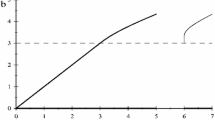Abstract
This paper establishes existence and uniqueness of Quantal Response Equilibrium (QRE) in a double auction. The concept of QRE has the intuitive property that a deviation from best response is less likely the higher the cost associated with the deviation itself. Thanks to such property, the QRE accommodates stochastic elements in the analysis of the strategic decision-making that arises in the double auction. By providing a theoretical alternative to the Bayesian Nash Equilibrium model, the QRE model offers an appealing tool for analyzing data of double auction experiments.
Similar content being viewed by others
Notes
In particular, a good fit is often achieved when the parameters of the distribution of payoff perturbations are estimated in order for the predicted outcome distribution to match the data as well as possible.
In a \(k\)-double auction with \(m\) buyers and \(n\) sellers (\(n,m \ge 2\)) the trading price is set at \(p = (1-k) \psi _{(m)} + k \psi _{(m+1)}\) with \(k \in [0,1]\) and bids and asks ordered in a list as \(\psi _{(1)} \le \psi _{(2)} \le ... \le \psi _{(m+n)} \). Buyers with a bid larger than or equal to \(p\) and sellers with an ask smaller than or equal to \(p\) will trade. In particular, if \(k = 1\) (\(k = 0\)), the double auction is called a buyer’s-bid auction (seller’s-ask auction) because in the bilateral case (\(n=m=1\)) the buyer’s bid (the seller’s ask) is the price whenever trade occurs.
If excess demand or excess supply arises, priority is given to sellers whose asks are smallest and to buyers whose bids are largest. A fair lottery then determines who trades among the remaining subjects on the long side of the market.
References
Anderson, S., Goeree, J., Holt, C.: Rent seeking with bounded rationality: an analysis of the all-pay auction. J. Political Econ. 106(4), 828–853 (1998)
Anderson, S., Goeree, J., Holt, C.: The logit equilibrium: a perspective on intuitive behavioral anomalies. South. Econom. J. 69(1), 21–47 (2002)
Capra, C., Goeree, J., Gomez, R., Holt, C.: Anomalous behavior in a traveler’s dilemma? Amer. Econom. Rev. 89(3), 678–690 (1999)
Cason, T., Friedman, D.: Price formation in single call markets. Econometrica 65(2), 311–345 (1997)
David, H.A., Nagaraja, H.N.: Order statistics, 3rd edn. Wiley (2003)
Goeree, J., Holt, C.: Ten little treasures of game theory and ten intuitive contradictions. Amer. Econom. Rev. 91(5), 1402–1422 (2001)
Goeree, J., Holt, C., Palfrey, T.: Quantal response equilibrium and overbidding in private-value auctions. J. Econom. Theory 104(1), 247–272 (2002)
Hartman, P.: Ordinary differential equations, 2nd edn. Birkhäuser (1982)
McKelvey, R., Palfrey, T.: Quantal response equilibria for normal form games. Games Econom. Behav. 10(1), 6–38 (1995)
Neri, C.: Eliciting beliefs in continuous-choice games: a double auction experiment. Working paper (2013)
Satterthwaite, M., Williams, S.: Bilateral trade with the sealed bid \(k\)-double auction: existence and efficiency. J. Econom. Theory 48(1), 107–133 (1989)
Williams, S.R.: Existence and convergence of equilibria in the buyer’s bid double auction. Rev. Econom. Stud. 58(2), 351–374 (1991)
Author information
Authors and Affiliations
Corresponding author
Appendices
Appendix 1
Consider a double auction with \(m\) buyers and \(n\) sellers. Denote the density functions of the bids and the asks with \(g_{b}\) and \(g_{s}\), respectively, and the cumulative density functions with \(G_{b}\) and \(G_{s}\), respectively. The formula for a buyer’s expected payoff [Eq. (1)] employs the formula of the joint density of the \(m\)th and (\(m+1\))th order statistics of the \(m+n-1\) bids and asks, \(f^B_{(m),(m+1)}\). Denote \(k=m\). Then:
The formula for a seller’s expected payoff [Eq. (2)] employs the formula of the joint density of the \((m-1)\)th and \(m\)th order statistics of the \(m+n-1\) bids and asks, \(f^S_{(m-1),(m)}\). Denote \(k=m-1\). Then:
Appendix 2
By differentiating Eqs. (3) and (4) with respect to \(y\), we obtain two differential equations in the choice densities:
We obtain \( \pi '_{B}( y )\) and \(\pi '_{S}( y )\) by differentiating the payoff functions \( \pi _{B}\) and \(\pi _{S}\) with respect to bid \(b\) and ask \(a\), respectively, and evaluating \( \pi '_{B}\) and \(\pi '_{S}\) at \(b=y\) and \(a=y\), respectively. For the buyer, differentiating \( \pi _{B}\) produces:
which simplifies to:
In (26) \( f^{B}_{(m)}(y)\) is the density of \(\zeta _{(m)}\) evaluated at a bid \(b=y\):
where:
In (26) \(M (y)\) corresponds to:
Therefore:
For the seller, differentiating \(\pi _{S}\) produces:
which simplifies to:
In (29) \( f^{S}_{(m)}(y)\) is the density of \(\zeta _{(m)}\) evaluated at an ask \(a=y\):
where:
In (29) \(N (y)\) corresponds to:
Therefore:
Functions \(f^{B}_{(m)}(y)\), \(f^{S}_{(m)}(y)\), \(K(y)\), \(L(y)\), \(M(y)\), \(H(y)\), \(Q(y)\), and \(N (y)\) are functions of \( G_{b}\) and \(G_{s}\), the cumulative distribution function of other buyers’ bids and sellers’ asks, respectively, and \(g_{b}\) and \(g_{s}\), the corresponding density functions. They can be computed using the formulas for the density of order statistics (David Nagaraja 2003).
Plugging (28) in (24) and (31) in (25), we obtain:
Rights and permissions
About this article
Cite this article
Neri, C. Quantal response equilibrium in a double auction. Econ Theory Bull 3, 79–90 (2015). https://doi.org/10.1007/s40505-014-0038-4
Received:
Accepted:
Published:
Issue Date:
DOI: https://doi.org/10.1007/s40505-014-0038-4



